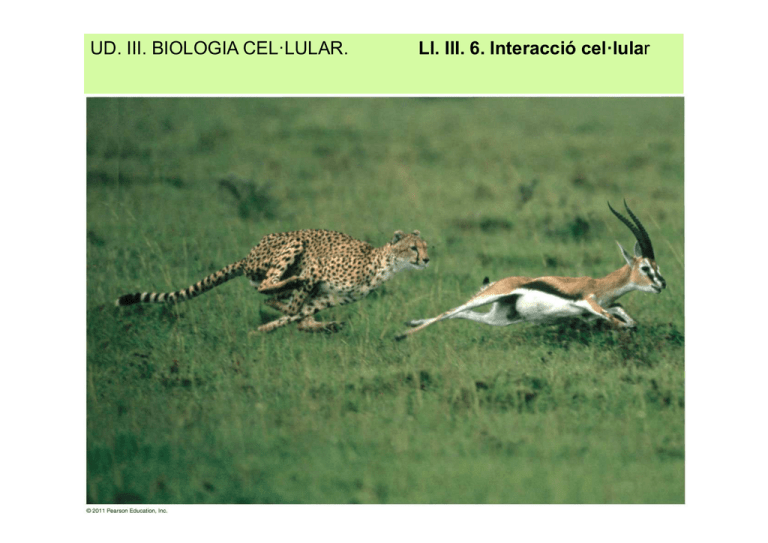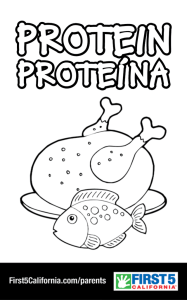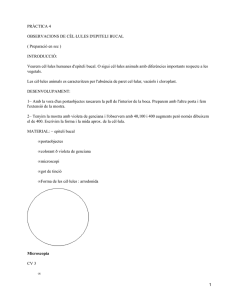UD III 6 Interacció cel·lular.pdf
Anuncio

UD. III. BIOLOGIA CEL·LULAR. Ll. III. 6. Interacció cel·lular Pluricel·lularitat Tipus d’unió entre cèl·lules Paret cel·lular vegetal Matriu exterior de la membrana cel·lular Desmosoma Plasmodesma Comunicació entre cèl·lules pròximes Comunicació entre cèl·lules distants Hormones Difusió Receptors de membrana UD. III. BIOLOGIA CEL·LULAR. Ll. III. 6. Interacció cel·lular 1. Pluricel·luritat Avantatge evolutiva Necessitat d’unió entre cèl·lules Necessitat de comunicació La pluricel·lularitat s’ha produit diverses vegades dins l’evolució dels organismes Membrana plasmàtica carbohydrate extracellular fluid (outside) protein glycoprotein extracellular matrix binding site attachment protein receptor protein phospholipid phospholipid bilayer pore transport protein cholesterol recognition protein enzyme cytoskeleton cytoplasm (inside) Fig. 5-1 Les cèl·lules procariotes són sempre unicel·lulars. Colònies de cèl·lules es presenten unides Poden formar biofilms, però no perden la independència Bacterial cells Polysaccharide biofilm UD. III. BIOLOGIA CEL·LULAR. Ll. III. 6. Interacció cel·lular 3. Tipus d’unió entre cèl·lules Les cèl·lules s’uneixen formant teixits (unió de cèl·lules d’idèntica estructura i un mateix origen embrionari. Els teixits s’uneixen per formar òrgans. UD. III. BIOLOGIA CEL·LULAR. Ll. III. 6. Interacció cel·lular 2.1. Paret cel·lular (cèl·lula vegetal) Primary cell walls Middle lamella Primary Cell Walls of Plants Are Fiber Composites Side view Top view Cellulose microfibril Primary cell wall Pectin Plasma membrane Cross-links UD. III. BIOLOGIA CEL·LULAR. Ll. III. 6. Interacció cel·lular 2.2. Matriu externa de les cèl·lules animals Membrana plasmàtica carbohydrate extracellular fluid (outside) protein glycoprotein extracellular matrix binding site attachment protein receptor protein phospholipid phospholipid bilayer pore transport protein cholesterol recognition protein enzyme cytoskeleton cytoplasm (inside) Fig. 5-1 Matriu extracel·lular Collagen molecules are made of three chains that wind around each other. 3 chains Collagen molecule Collagen fibrils in the extracellular matrix Cell in connective tissue Collagen fibrils Collagen fibrils Each collagen fibril is Collagen fibrils in the extracellular matrix Cell in connective tissue Collagen fibrils running lengthwise Collagen fibrils in cross section Each collagen fibril is composed of many collagen molecules Unions estretes Electron micrograph of a tight junction Three-dimensional view of a tight junction A tight junction forms a watertight seal between epithelial cells Plasma membranes of adjacent cells Tight junction Membrane proteins that form a tight junction Desmosomes Micrograph of desmosome 3-D view of desmosome Plasma membranes of adjacent cells Desmosome Anchoring proteins inside cell Membrane proteins that link cells Intermediate filaments UD. III. BIOLOGIA CEL·LULAR. Ll. III. 6. Interacció cel·lular 3. Comunicació entre cèl·lules pròximes Comunicació paracrina Comunicació sinàptica Local signaling Electrical signal along nerve cell triggers release of neurotransmitter. Target cell Secreting cell Local regulator diffuses through extracellular fluid. (a) Paracrine signaling Neurotransmitter diffuses across synapse. Secretory vesicle Target cell is stimulated. (b) Synaptic signaling Plasma membranes Gap junctions between animal cells Cell junctions Cell-cell recognition Plasmodesmata between plant cells Unió i comunicació directa entre cèl·lules adjacents Gap junctions create gaps that connect animal cells. Gap junctions Membrane proteins from adjacent cells line up to form a channel Comunicació directa a les cèl·lules vegetals: Plasmodesmes Plasmodesmata create gaps that connect plant cells. Cell walls Tubule of endoplasmic reticulum passing through plasmodesmata Membrane of cell 1 Smooth endoplasmic reticulum Cell wall Cell wall of cell 1 of cell 2 Membrane of cell 2 UD. III. BIOLOGIA CEL·LULAR. Ll. III. 6. Interacció cel·lular 4. Comunicació entre cèl·lules distants La comunicació entre cèl·lules allunyades es fa a través de les hormones. Es formen a cèl·lules determinades i són transportades a altres llocs on exerceixen els seus efectes. Substàncies de composició química molt variable. Es presenten en baixa concentració. Tenen efectes importants sobre els organismes. Tenene fectes diferents en animals i plantes. Alguns exemples: etilé, auxina (vegetals), estrogen, insulina, tiroxina (animals). UD. III. BIOLOGIA CEL·LULAR. Ll. III. 6. Interacció cel·lular 5. Comunicació entre cèl·lules distants Les hormones actúen seguint tres passos: Recepció: La hormona ha de ser reconeguda per la cèl·lula objectiu: Entrada directa o ús de receptors de membrana. Transducció: Reacció de transformació a l’interior de la cèl·lula. Resposta: Elaboració de la resposta que pot ser molt diversificada Long-distance signaling Endocrine cell Blood vessel Hormone travels in bloodstream. Target cell specifically binds hormone. (c) Endocrine (hormonal) signaling Hormones esteroides de composició lipídica que poden atravessar lliurament la membrana. Plasma membrane Steroid hormone 1. Steroid hormone diffuses across plasma membrane into cell. 2. Hormone binds to receptor, inducing conformational change. Receptor in cytosol Nucleus 3. Hormone-receptor complex binds to DNA, inducing change in gene activity. Target gene DNA Hormona captada per un receptor de membrana que provoca una resposta a l’interior del citoplasma i una posterior amplificació de la senyal rebuda. Intercellular signal Outside of cell Receptor protein in membrane 1. Signal is received. Inside of cell 2. Signal is transduced. Intracellular signal 3. Signal is amplified. Cell activity changes For example, specific genes or proteins are activated or deactivated. 4. Cell responds. G proteïnes, actúen com a segon missatger HOW DO G PROTEINS WORK? Enzyme Signal Receptor Enzyme GTP Substrate Second messenger GTP GDP G protein in “off” conformation G protein in “on” conformation 1. G protein binds GDP. Signal 2. Signal-receptor complex changes arrives and binds to receptor. conformation. G protein binds GTP and splits into two parts. Triggers response 3. In response to binding of activated G protein, enzyme catalyzes a reaction that produces a second messenger. G proteïnes, actúen com a segon missatger Signal Receptor Enzyme GDP G protein in “off” conformation 1. G protein binds GDP. Signal arrives and binds to receptor. G proteïnes, actúen com a segon missatger GTP G protein in “on” conformation 2. Signal-receptor complex changes conformation. G protein binds GTP and splits into two parts. G proteïnes, actúen com a segon missatger Enzyme GTP Substrate Second messenger Triggers response 3. In response to binding of activated G protein, enzyme catalyzes a reaction that produces a second messenger. Fosforilació en cascada GTP P ATP ADP Inactive protein 1 Inactive protein 2 Signal GDP GDP Ras protein P Active protein 1 P ATP ADP P Active protein 2 ATP ADP Inactive protein 3 Triggers response Ras protein Receptor tyrosine kinase (RTK) P GTP ATP ADP Bridging proteins 1. Signal arrives and binds to 2. Signal-receptor complex 3. Proteins form a bridge to Ras. 4. Ras catalyzes the receptor. changes conformation and is phosphorylated. Ras exchanges its GDP for a GTP. phosphorylation of an intracellular protein, activating it. 5. Phosphorylation cascade results, each protein phosphorylating another until a response is triggered in the cell. Fosforilació en cascada Signa l GDP GDP Ras protein P ATP ADP Receptor tyrosine kinase (RTK) 1. Signal arrives and binds to 2. Signal-receptor complex receptor. changes conformation and is phosphorylated. Fosforilació en cascada GD P P ATP ADP 2. Signal-receptor complex changes conformation and is phosphorylated. GTP P Bridging Ras proteins protei n 3. Proteins form a bridge to Ras. Ras exchanges its GDP for a GTP. Fosforilació en cascada 4. Ras catalyzes the GTP phosphorylation of an intracellular protein, activating it. P ATP ADP Inactive protein 1 Inactive protein 2 Inactive protein 3 P Active protein 1 ATP ADP P Active protein 2 ATP ADP Triggers response 5. Phosphorylation cascade results, each protein phosphorylating another until a response is triggered in the cell. Desactivació de la senyal Tan important com l’activació de senyals és la seva desactivació. La cèl·lula té mecanismes per controlar aquests processos. Són molt sensibles a l’augment i disminució de la concentració d’hormones. El funcionament del mecanisme implica una coordinació general de l’activitat a tot l’organisme.

